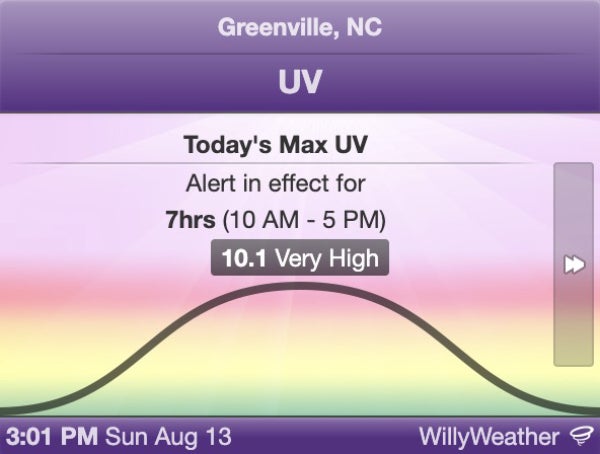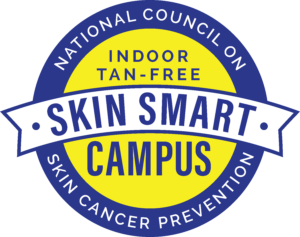Skin Smart Campus Initiative
East Carolina University has been recognized as a Skin Smart Campus by The National Council on Skin Cancer Prevention. Ensuring the well-being of our students, we are providing a safe and healthy learning and living environment on and off campus, pledging to keep indoor tanning devices off our campus and our affiliated buildings. We also promote skin cancer prevention policies and education.
The Indoor Tan-Free Skin Smart Campus Initiative is sponsored by the National Council on Skin Cancer Prevention in response to the 2014 U.S. Surgeon General’s Call to Action to Prevent Skin Cancer (PDF) which concluded that there is a strong association between increased risk of skin cancer and indoor tanning use. Ultraviolet (UV) radiation exposure from indoor tanning is completely avoidable which allows for interventions to help reduce skin-cancer related illness and deaths. Numerous studies have found that skin cancer is the most common type of cancer in the United States, with melanoma as one of the most common cancers diagnosed among young adults. According to The International Agency for Research on Cancer Working Group, the use of indoor tanning facilities before the age of 35 increases the risk for melanoma by 75 percent.
Skin Cancer
Skin cancer is the most common cancer in the United States that will affect nearly one and five Americans in their lifetimes.1 The two most common forms of skin cancer (basal cell carcinoma and squamous cell carcinoma) are highly curable but can lead to unwanted scarring or disfigurement. Melanoma is the third most common type of skin cancer and can be deadly. However, there are preventative measures that can reduce your chance of developing skin cancer like limiting ultraviolet light (UV) exposure from sunlight or artificial UV lights along with the use of sunscreen, protective clothing, and seeking shaded areas.
Risk Factors for Skin Cancer
- Personal or family history of skin cancer
- History of sun exposure
- History of sunburns, especially early in life
- History of indoor tanning
- Average tanning bed produces 2 to 10x more UVA radiation than the sun
- Tanning bed use before the age of 35 increases a person’s risk of developing melanoma by 75%
- Large number of moles
- Light skin that burns, freckles, or reddens easily
- However, skin of all colors can get skin cancer!
Skin Cancer in People of Color
Even people with darker skin tones who rarely burn or always tan can get skin cancer. This includes people of African, Asian, Latino, Mediterranean, Middle Eastern and Native American descent. People of color often are diagnosed with skin cancer later, making the cancer harder to treat. No matter the skin tone, UV radiation can lead to skin damaging, premature aging and hyperpigmentation – protecting your skin is important!
Melanoma in people of color can occur on the palms of the hands, soles of the feet, under the nail (subungual) and in the nail areas. They can also arise beneath the nail, so it is important to check these areas for new pigmented lesions and tell your doctor if you have any new or changing spots or sores that won’t heal.
Limiting UV Exposure
Checking the UV Index is an important way to plan for sun protection. You can find the UV Index on your phone’s weather app or click Weather.gov.
Dermatologists recommend sun protection when the UV Index is a 3 or higher. As levels approach a UV Index of 6+, it is best to limit your time in the sun.
Below are other tips for sun safety:
 Seek Shade
Seek Shade
- Find shade under a dense tree canopy, shade sail, or pavilion
- Carry a sun umbrella for personal shade
- Use a pop-up UV tents when at the beach or park
- Whenever possible, stay out of the sun from 10 AM – 4 PM when UV radiation is the strongest
 Wear Sunscreen
Wear Sunscreen
- Broad spectrum UVA and UVB, SPF 30 or higher
- Reapplication is necessary every 2 hours and after swimming, sweating, or toweling off
- Most people do not put on enough sunscreen–aim for one ounce, which is about a palmful
 Wear Protective Clothing
Wear Protective Clothing
- Long sleeves/pants with a dense weave or built in UPF
- Wide-brimmed hat
- Closed-toe shoes and socks that cover the ankle
 Wear Sunglasses
Wear Sunglasses
- Choose sunglasses with a UV protective coating
- Wearing sunglasses helps protect the delicate skin around our eyes
- UV rays can also increase risk of cataracts & macular degeneration–it makes sense to protect your eyes!
Today’s UV Forecast for Greenville, NC
Click image to view current forecast

ABCDEs of Melanoma
Melanoma is the deadliest form of skin cancer, but when detected early, it is highly treatable. It’s important to know your skin by performing a self-exam of your skin each month. Ask a partner or a friend to look at your back and scalp! The guide below can help you recognize any warning signs that you should show your health care provider! The ABCDEs of Melanoma are a guide for evaluating moles for possible signs of melanoma:
 Asymmetry: Moles that have an asymmetrical appearance
Asymmetry: Moles that have an asymmetrical appearance
 Border: A mole with a blurry and/or jagged edge
Border: A mole with a blurry and/or jagged edge
 Color: A mole that has more than one color
Color: A mole that has more than one color
 Diameter: Moles with a diameter larger than a pencil eraser (6 mm or ¼ inch)
Diameter: Moles with a diameter larger than a pencil eraser (6 mm or ¼ inch)
 Evolution: A mole that has changed in size, shape or color
Evolution: A mole that has changed in size, shape or color
Link for how to perform a Self Skin Exam.
Resources
National Council on Skin Cancer Prevention:
Facebook: @natlcouncilskincancerprevention
Instagram: @skincancerprev
American Academy of Dermatology:
Skin Cancer Prevention
Skin Cancer Foundation:
Skin Cancer Facts & Stats
Skin Cancer in People of Color
Melanoma Research Foundation (MRF):
Preventing Melanoma
Educator Course for Healthcare Students
Sunscreen Dispensers Locations:
Coming Soon
